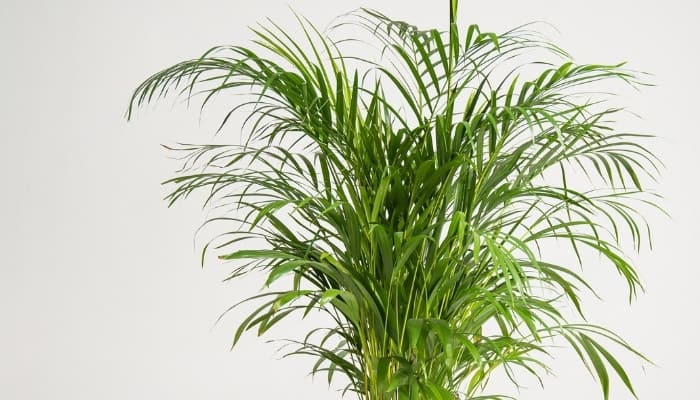Palm trees are members of the Arecaceae family, a type of flowering plant that grows year after year. They are commonly found in subtropical and tropical regions and are highly valued for their decorative qualities.
Can you grow a palm tree indoors? Palm trees make excellent houseplants; they are easy to care for, are pest resistant, and come in many varieties. Indoor palms enjoy light fertilization, frequent watering, and lots of bright, indirect light, and generally prefer a medium to high humidity level. Misting palm leaves is helpful.
Growing and caring for indoor palm trees isn’t nearly as hard as you might think. With just a few tips provided below, you can enjoy the peaceful tranquility of living among thriving indoor palm trees.
How To Grow a Palm Tree Indoors
Palm trees aren’t the hardest houseplants to grow and care for indoors. That said, they do have a few unyielding points about them to be aware of.
Below, we discuss how to grow a palm tree indoors step by step, including everything from choosing the best species and container to what soil to use, how often to water and fertilize, and everything else you need to know.
Choosing the Best Variety
There are numerous palm tree species to choose from when deciding what type of palm tree you want as a houseplant (scroll down to view the most popular).
Palm varieties vary greatly. For example, some palms are more tolerant of dry air, whereas others need the highest humidity levels possible.
Container Size
Technically speaking, palm trees will grow indoors in pots of nearly any size. However, many palms outgrow small and medium-sized pots rather quickly in comparison to other common houseplants.
Medium to large pots is the most highly recommended for growing palm trees indoors.
The pot doesn’t just need to be big though, it also needs to be heavy duty so that it doesn’t fall over (and if it does, it won’t break).
Type of Potting Soil
Indoor palm trees enjoy loose and fluffy type soil. Peat moss, shredded bark, and potting soil for flowers is a great mix to start with.
Many gardening centers carry soil mixtures that are specifically designed for palm trees. These are always the best option. For example, this parlor palm mix would be ideal for most potted palms.
Watering
Palms require enough water that they stay rather moist, more so than many other houseplants. Typically, once every 3-4 days to once per week is ideal.
That said, when they are first planted or otherwise moved into your home, palms should be watered every day. Over the next few weeks, stagger the watering until you’re only watering the palm every 3rd or 4th day.
Fertilizing
Palm trees prefer being only lightly fertilized compared to many plants. An NPK ratio of 3:1:3 is recommended.
Slow-release fertilizer, like this one designed specifically for palms, is also recommended; that way nutrients are given to the plant over time and you won’t need to apply fertilization as often.
Plant Placement
The perfect placement for an indoor palm tree is somewhere that the plant will receive plenty of bright but indirect sunlight. South- or west-facing windows are the most highly recommended placements.
If your palm isn’t near a window it will need lots of man-made light from full-spectrum grow lights.
Lighting
Palms prefer to be bathed in loads of indirect bright light. At the same time, however, they are awfully tolerant of shade.
They may not thrive in low-light situations, but they will more than likely survive. This is especially helpful during the wintertime when they are inside with less light than they are used to receiving.
Pruning
Palm trees need pruning just like any other plant. When leaves are damaged or dying, they are ready to be snipped off.
You may also need to cut any of the fronds that get too large, especially if they are near a walkway or furniture where people will keep brushing into them.
Types of Indoor Palm Trees
There are at least two dozen common palm trees that folks keep inside their homes all year round.
These eight are the most popular types of indoor palm trees:
- Areca Palm
- Cascade Pal
- Chinese Fan Palm
- Majesty palm
- Parlor Palm
- Ponytail Palm
- Sago Palm
- Yucca Palm
Indoor Palm Tree Care Tips

Growing palm trees indoors is easy and breezy once you know what to do. Below, we offer some of the best care tips for growing healthy and happy indoor palms:
Pay Attention to the Lighting
The biggest mistake is to just set your palm anywhere inside and think it has enough light. Instead, make sure it has plenty of bright but indirect light (be it man-made or sun from a window).
Direct sunlight should be avoided as it burns leaves.
Keep the Plant’s Soil Moist
Keeping the palm’s soil moist is a must. These are tropical and sub-tropical plants; they require moist soil and humid air (or plenty of misting).
Fertilize the Soil
Use fertilizer only once or twice per year, and go lightly when you do. Slow-release fertilizer is preferred as it provides the most evenly distributed nutrients over the longest period of time.
Practice Pest Control
Practicing basic pest control is a must for growing palm trees indoors. If infestations aren’t prevented, they may wreak havoc on your plant and then spread to others.
Prune as Needed
Be sure to prune your palm occasionally, especially when it is indoors and close at hand. There is no need to go heavy handed with the snipping; just remove the dead and brown fronds.
Problems To Watch For
A few of the most common problems you may encounter while growing indoor palms are:
Fungal Disease
Fusarium wilt and Ganoderma butt rot are the two main fungal diseases you need to look out for. One is caused by the Fusarium oxysporum fungus, which attacks the leaves of the plant.
The other is caused by the Gonderma zonatum fungus, which infects the stems and roots.
Bud rot is a third fungal disease caused by two fungi: Phytophthora palmivora and Thielaviopsis paradoxa.
Leaf Spot
Aside from fungal disease, leap spot is another disease to look out for. There are several fungi and other conditions that may cause leaf spots to appear.
Leaves should be promptly removed once spots are detected.
Related Questions:
Those interested in growing indoors palms were also curious about:
How Do You Keep a Palm Tree Alive Indoors During the Winter?
To keep your palm tree alive during the winter, pot it up, take it inside, and keep a close eye on it. Water it twice per week, give it plenty of light, and possibly add some nutrients to the soil.
Should I Cut Off Brown Palm Leaves?
Many brown fronds will fall off of the palm tree naturally as a result of aging.
However, leaves that are brown, not from aging but from pests, moisture, or something else, should be cut off immediately.
A Final Word About Growing a Palm Tree Indoors
Palm trees are a relatively simple houseplant to grow and care for that you can enjoy with little fuss. Just remember to keep them well lit, moist, and misted (or humid), and they will remain happy and healthy.

